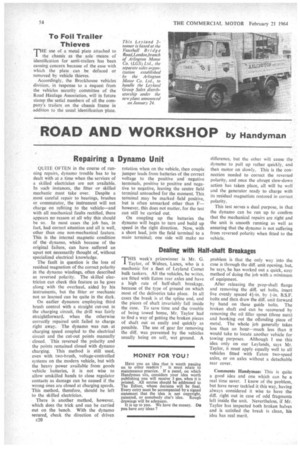ROAD AND WORKSHOP by Handyman
Page 56

If you've noticed an error in this article please click here to report it so we can fix it.
Repairing a Dynamo Unit
QUITE OFTEN in the course of running repairs, dynamo trouble has to he dealt with at a time when the services of a skilled electrician are not available. In such instances, the fitter or skilled mechanic must take over. Despite a most careful repair to bearings, brushes or commutator, the instrument will not charge on refitting to the vehicle—and with all mechanical faults rectified, there appears no reason at all why this should be so. In most cases the job has, in fact, had correct attention and all is well, other than one non-mechanical feature. This is the internal magnetic condition of the dynamo, which because of the original failure, can have suffered an upset not necessarily thought of, without specialized electrical knowledge.
The fault in question is the loss of residual magnetism of the correct polarity in the dynamo windings, often described as reversed polarity. The skilled electrician can check this feature as he goes along with the overhaul, aided by his instruments, but the fitter or mechanic not so learned can be quite in the dark.
On earlier dynamos employing third brush control with a straight cut-out in the charging circuit, the drill was fairly straightforward, when the otherwise correctly repaired unit failed to charge right away. The dynamo was run at charging speed coupled to the electrical circuit and the cut-out points manually closed. This reversed the polarity and the points remained closed with dynamo charging. This method is still used, even with two-brush, voltage-controlled systems on the modern vehicle, but with the heavy power available from goods vehicle batteries, it is not wise to allow unskilled hands to close regulator contacts as damage can be caused if the wrong Ones are closed at charging speeds. This method, therefore, should be left to the skilled electrician.
There is another method, however, which does the trick and can be carried out on the bench. With the dynamo secured, check the direction of driven c20 rotation when on the vehicle, then couple jumper leads from batteries of the correct voltage to the positive and negative terminals, positive to positive and negative to negative, leaving the centre field terminal untouched for the moment. This terminal may be marked field positive, but is often unmarked other than F— however, this does not matter, for the test can still be carried out.
On coupling up the batteries the dynamo will begin to turn and build up speed in the right direction. Now, with a short lead, join the field terminal to a main terminal; one side will make no
difference, but the other will cause the dynamo to pull up rather quickly, and then motor on slowly. This is the connection needed to correct the reversed polarity, and once the abrupt slow-down action has taken place, all will be well and the generator ready to charge with its residual magnetism restored in correct polarity.
This test serves a dual purpose, in that the dynamo can be run up to confirm that the mechanical repairs are right and the unit is smooth running as well as ensuring that the dynamo is not suffering from reversed polarity when fitted to the vehicle.
























































































































